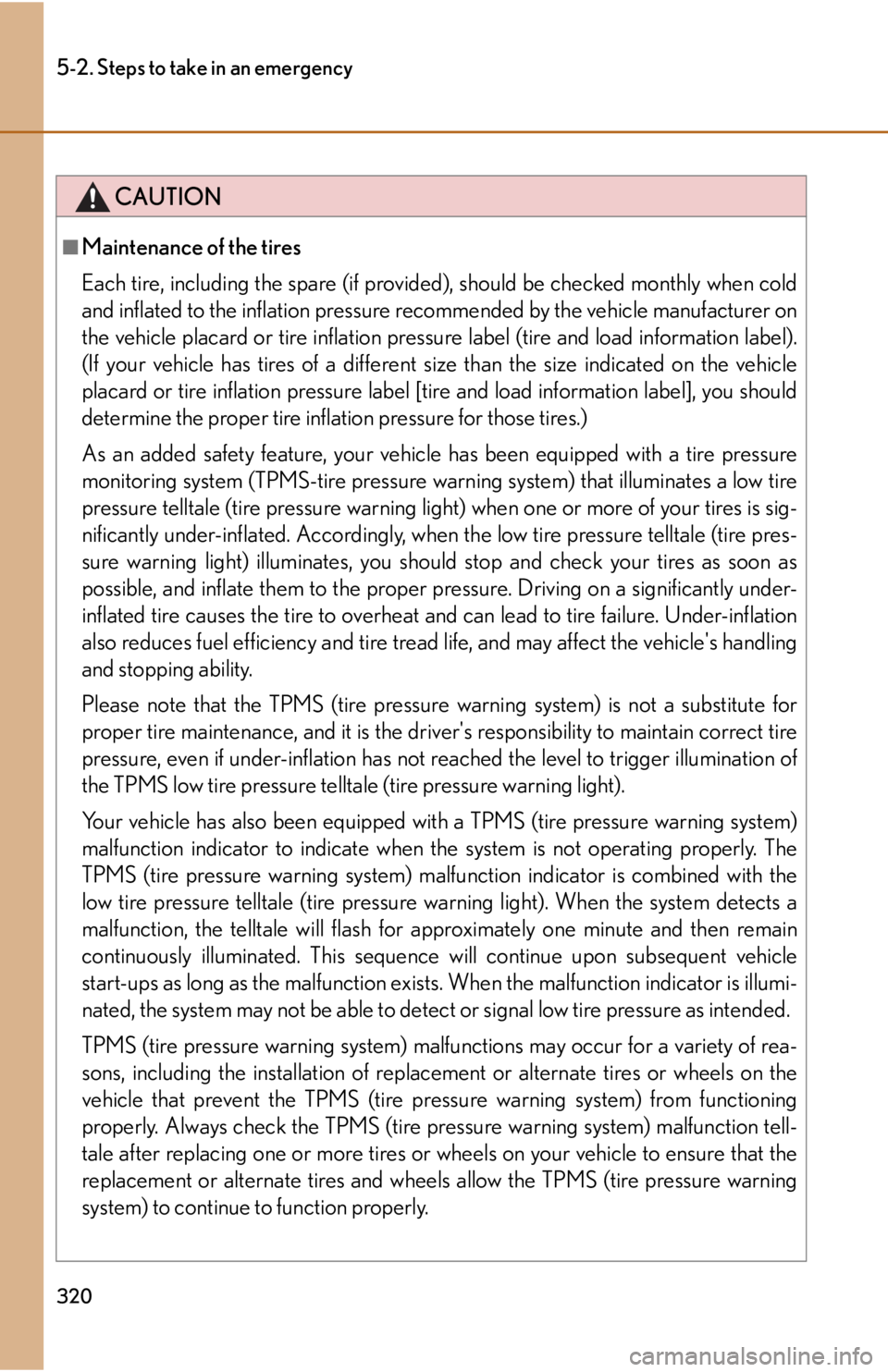Page 322 of 420

320
5-2. Steps to take in an emergency
CAUTION
■Maintenance of the tires
Each tire, including the spare (if provided), should be checked monthly when cold
and inflated to the inflation pressure re commended by the vehicle manufacturer on
the vehicle placard or tire inflation pressu re label (tire and load information label).
(If your vehicle has tires of a different size than the size indicated on the vehicle
placard or tire inflation pressure label [tire and load information label], you should
determine the proper tire inflation pressure for those tires.)
As an added safety feature, your vehicl e has been equipped with a tire pressure
monitoring system (TPMS-tire pressure warning system) that illuminates a low tire
pressure telltale (tire pressure warning light) when one or more of your tires is sig-
nificantly under-inflated. Accordingly, when the low tire pressure telltale (tire pres-
sure warning light) illuminates, you should stop and check your tires as soon as
possible, and inflate them to the proper pressure. Driving on a significantly under-
inflated tire causes the tire to overheat and can lead to tire failure. Under-inflation
also reduces fuel efficiency and tire tread life, and may affect the vehicle's handling
and stopping ability.
Please note that the TPMS (tire pressure warning system) is not a substitute for
proper tire maintenance, and it is the driv er's responsibility to maintain correct tire
pressure, even if under-inflation has not reached the level to trigger illumination of
the TPMS low tire pressure telltale (tire pressure warning light).
Your vehicle has also been equipped with a TPMS (tire pressure warning system)
malfunction indicator to indicate when th e system is not operating properly. The
TPMS (tire pressure warning system) malfunction indicator is combined with the
low tire pressure telltale (tire pressure warning light). When the system detects a
malfunction, the telltale will flash for approximately one minute and then remain
continuously illuminated. This sequence will continue upon subsequent vehicle
start-ups as long as the malfunction exists . When the malfunction indicator is illumi-
nated, the system may not be able to detect or signal low tire pressure as intended.
TPMS (tire pressure warning system) malfunctions may occur for a variety of rea-
sons, including the installation of replacem ent or alternate tires or wheels on the
vehicle that prevent the TPMS (tire pres sure warning system) from functioning
properly. Always check the TPMS (tire pressure warning system) malfunction tell-
tale after replacing one or more tires or wheels on your vehicle to ensure that the
replacement or alternate tires and wheels allow the TPMS (tire pressure warning
system) to continue to function properly.
Page 345 of 420

5
When trouble arises
343
5-2. Steps to take in an emergency
If the engine will not start
If the engine will not start, even though correct starting procedures are being
followed (
P. 98), consider each of the following points.
■ The engine will not start even when the starter motor operates nor-
mally.
One of the following may be the cause of the problem.
● There may not be sufficient fuel in the vehicle’s tank.
Refuel the vehicle.
● The engine may be flooded.
Try to restart the engine once more following correct starting pro-
cedures. ( P. 9 8 )
● There may be a malfunction in the engine immobilizer system.
( P. 5 3 )
■ The starter motor turns over slowly , the interior lights and headlights
are dim, or the horn does not sound or sounds at a low volume.
One of the following may be the cause of the problem.
● The battery may be discharged. ( P. 3 4 8 )
● The battery terminal connections may be loose or corroded.
■ The starter motor does not turn over, the interior lights and head-
lights do not turn on, or the horn does not sound.
One of the following may be the cause of the problem.
● One or both of the battery terminals may be disconnected.
● The battery may be discharged. ( P. 3 4 8 )
Contact your Lexus dealer if the prob lem cannot be repaired, or if repair
procedures are unknown.
Page 359 of 420
Vehicle specifications6
357
6-1. SpecificationsMaintenance data (fuel, oil level, etc.) .............. 358
Fuel information ..................... 368
Tire information....................... 371
6-2. Customization Customizable features ........ 383
6-3. Initialization Items to initialize .................... 386
Page 360 of 420
358
6-1.Specifications
Maintenance data (fuel, oil level, etc.)
Vehicle identification
■ Vehicle identification number
The vehicle identification number (V IN) is the legal identifier for your
vehicle. This is the primary identi fication number for your Lexus. It is
used in registering the ownership of your vehicle.
This number is stamped on the top
left of the instrument panel and on
the floor behind the right seat.
This number is also on the Certifi-
cation Label.
Page 362 of 420
360
6-1. Specifications
Engine
Fuel
Model1LR-GUE
Ty p e10-cylinder V type, 4-cycle, gasoline
Bore and stroke3.50 3.10 in. (88.0 79.0 mm)
Displacement 293.2 cu.in. (4805 cm3)
Drive belt tensionAutomatic adjustment
Fuel typeUnleaded gasoline only
Octane rating91 (Research octane number 96) or higher
Fuel tank capacity
(Reference)19.3 gal. (73 L, 16.1 Imp. gal.)
NOTICE
■Fuel precaution
Do not use any fuel other than that specified above. Doing so may cause engine
damage.
Page 370 of 420

368
6-1. Specifications
Fuel information
Your vehicle must use only unleaded gasoline.
Premium unleaded gasoline with an octane rating of 91 (Research Octane
Number 96) or higher is required for optimum engine performance.
At minimum, the gasoline you use should meet the specifications of
ASTM D4814 in the U.S.A. and CGSB3.5-M93 in Canada.
■Fuel tank opening for unleaded gasoline
To help prevent incorrect fueling, your vehicle has a fuel tank opening that only
accommodates the special nozzle on unleaded fuel pumps.
■Gasoline quality
In very few cases, driveability problems may be caused by the brand of gasoline you
are using. If driveability problems persist, try changing the brand of gasoline. If this
does not correct the problem, consult your Lexus dealer.
■Gasoline quality standards
●Automotive manufacturers in the U.S.A., Europe and Japan have developed a
specification for fuel quality called the World-Wide Fuel Charter (WWFC),
which is expected to be applied worldwide.
●The WWFC consists of four categories that are based on required emission
levels. In the U.S., category 4 has been adopted.
●The WWFC improves air quality by lowering emissions in vehicle fleets, and
improves customer satisfaction through better performance.
■Recommendation of the use of gasoline containing detergent additives
●Lexus recommends the use of gasoline that contains detergent additives to
avoid the build-up of engine deposits.
●All gasoline sold in the U.S.A. contains detergent additives to clean and/or keep
clean intake systems.
Page 371 of 420

369
6-1. Specifications
6
Vehicle specifications
■Recommendation of the use of cleaner burning gasoline
Cleaner burning gasoline, including reformulated gasoline that contains oxygen-
ates such as ethanol or MTBE (Methyl Te rtiary Butyl Ether) is available in many
areas.
Lexus recommends the use of cleaner burning gasoline and appropriately blended
reformulated gasoline. These types of gasoline provide excellent vehicle perfor-
mance, reduce vehicle emissions and improve air quality.
■Non-recommendation of the use of blended gasoline
●Lexus allows the use of oxygenate blended gasoline where the oxygenate con-
tent is up to 10% ethanol or 15% MTBE.
●If you use gasohol in your vehicle, be sure that it has an octane rating no lower
than 87.
●Lexus does not recommend the use of gasoline containing methanol.
■Non-recommendation of the use of gasoline containing MMT
Some gasoline contains an octane enhancing additive called MMT (Methylcyclo-
pentadienyl Manganese Tricarbonyl).
Lexus does not recommend the use of gasoli ne that contains MMT. If fuel contain-
ing MMT is used, your emission control system may be adversely affected.
The malfunction indicator lamp on the inst rument cluster may come on. If this hap-
pens, contact your Lexus dealer for service.
■If your engine knocks
●Consult your Lexus dealer.
●You may occasionally notice light knocking for a short time while accelerating
or driving uphill. This is normal and there is no need for concern.
Page 372 of 420
370
6-1. Specifications
NOTICE
■Notice on fuel quality
●Do not use any fuel other than that specified. If improper fuels are used the
engine will be damaged.
●Do not use leaded gasoline.
Leaded gasoline can cause damage to your vehicle’s three-way catalytic convert-
ers causing the emission control system to malfunction.
●Do not use gasohol other than the type previously stated.
Other gasohol may cause fuel system damage or vehicle performance problems.
■Fuel-related poor driveability
If poor driveability is encountered after using a different type of fuel (poor hot start-
ing, vaporization, engine knoc king, etc.), discontinue the use of that type of fuel.
■When refueling with gasohol
Take care not to spill gasohol. It can damage your vehicle's paint.